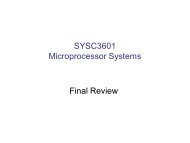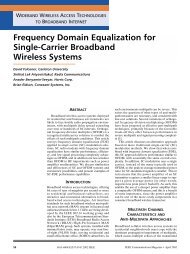Image Reconstruction for 3D Lung Imaging - Department of Systems ...
Image Reconstruction for 3D Lung Imaging - Department of Systems ...
Image Reconstruction for 3D Lung Imaging - Department of Systems ...
Create successful ePaper yourself
Turn your PDF publications into a flip-book with our unique Google optimized e-Paper software.
3.5 <strong>3D</strong> Considerations<br />
In EIT it is <strong>of</strong>ten assumed that the injected currents stay in the two-dimensional electrode<br />
plane [115]. This assumption has been used since the early days <strong>of</strong> EIT, however, it is<br />
obviously incorrect since electric currents will spread out in three dimensions.<br />
Reports <strong>of</strong> EIT in the clinical literature rarely use <strong>3D</strong> EIT possibly due to the difficulty <strong>of</strong><br />
applying large numbers <strong>of</strong> electrodes and the high data collection rate needed <strong>for</strong> monitoring<br />
physiological function. <strong>3D</strong> reconstruction algorithms concerning medical applications can<br />
be found in Gobel et al [59], Metherall et al [90], Polydorides [98], Polydorides and McCann<br />
[99], Blue et al [22] and Molinari et al [91]. In three dimensions the possibilities <strong>for</strong> electrode<br />
configurations and injection and measurement protocols are much larger than in 2D. With<br />
cylindrical tanks a typical configuration is to use equally spaced electrodes arranged on<br />
several parallel planes.<br />
The main problem with <strong>3D</strong> is computational: with three dimensional EIT the complexity<br />
<strong>of</strong> body shapes and components requires a finite element model with a large number <strong>of</strong><br />
elements. Since the storage and computing time increase as a function <strong>of</strong> the number <strong>of</strong><br />
elements either the mesh discretization must be left too coarse to obtain images unaffected<br />
by the element size or the mesh will so large that it causes the computer to run out <strong>of</strong> memory<br />
during solution [91]. One either has to parallelize the problem onto several processors [21],<br />
or investigate more efficient algorithms such as dual meshing [95]. The iterative Newton-<br />
Raphson method is suitable <strong>for</strong> small-scale EIT problems. However it can be unsuitable <strong>for</strong><br />
large <strong>3D</strong> problems where the number <strong>of</strong> elements can easily exceed 5000. This corresponds<br />
to a matrix size <strong>of</strong> 25 ×10 6 or a memory requirement <strong>of</strong> 200 MB to store the matrix alone.<br />
3.6 GOE MF Type II System<br />
A detailed analysis on EIT hardware design and analysis can be found in [58][40][129]. The<br />
first successful tomographic style impedance imaging was per<strong>for</strong>med by Barber and Brown<br />
in the early 80’s [15] using the Sheffield Mark 1 system [27] with the filtered backprojection<br />
reconstruction algorithm. This is a 16 electrode adjacent drive system that measures 12.5<br />
frames per second. The architecture <strong>of</strong> medical scanning equipment has not changed much.<br />
For example Viasys Healthcare, Höchberg, Germany manufactures the Goe-MF II type<br />
tomography system, which like the Sheffield Mk 1 has a single amplification unit and a<br />
single detection unit that are multiplexed to 16 electrodes. Both are intended <strong>for</strong> use with<br />
the adjacent constant current drive. The EIT group at Goettingen has improved the basic<br />
system by optimizing some analog components and digitizing the signal at an earlier stage<br />
<strong>of</strong> the processing. This has provided a large improvement in signal to noise ratio <strong>of</strong> the<br />
EIT signal. In [62] they reported that the Goe-MF type II provides an order <strong>of</strong> magnitude<br />
improvement in SNR over the Sheffield Mk 1. Like the Sheffield Mk 1 this machine is<br />
intended to be used to collect 2D data from a planar set <strong>of</strong> 16 electrodes equispaced around<br />
the thorax. The default reconstruction algorithm is a functional image based on individual<br />
frames reconstructed using filtered backprojection [62]. However the raw measurement data<br />
can be exported <strong>for</strong> use with algorithms not included with the Goe-MF II. This machine<br />
was used to obtain empirical data used to verify some <strong>of</strong> the work in this thesis.<br />
44





